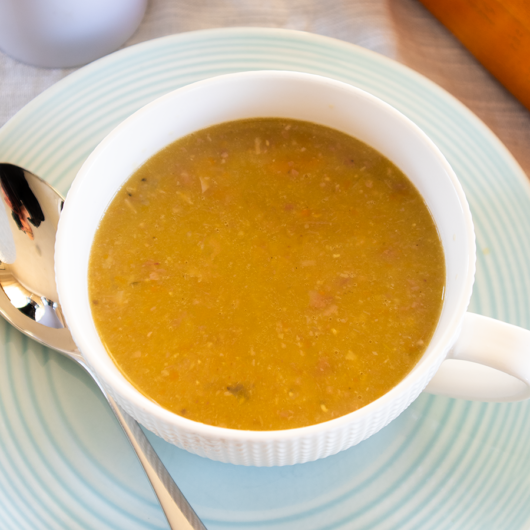Each year in winter I make a huge batch of this winter pea & ham soup. I divide into meal size containers and consume for work lunches and quick after work dinners.
I’ve always based my recipe on the one in the original Cooks Companion by legendary Australian chef, Stephanie Alexander (albeit with some minor tweaks).
I’m fortunate to have a first edition, published in 1996. If memory serves me well, I received as a Christmas gift that year and it became my go-to reference book for years. It’s still very handy when Im’ just looking for ideas, right down to ingredient matches.
The cover may have changed since 1996, but the book is still packed with useful tips, hints and great recipes. It goes to show that good food doesn’t go out of fashion, but fads do.
But without further ado, here’s the recipe, with tweaks. Scroll below the recipe for more about this fabulous, warming, indeed the best winter pea and ham soup you can make every year.
A little more about my warming pea and ham soup
I like to find out more about the history of some foods I cook. While writing, I started thinking of the English phrase “pea souper”, referring to thick fog. So I did a quick search and came up with a Wikipedia page. Its opening text on the history of pea soup state:
Pea soup has been eaten since antiquity; it is mentioned in Aristophanes’ The Birds, and according to one source “the Greeks and Romans were cultivating this legume about 500 to 400 BCE. During that era, vendors in the streets of Athens were selling hot pea soup.”[1]
Eating fresh “garden” peas before they were matured was a luxurious innovation of the Early Modern period:[2] by contrast with the coarse, traditional peasant fare of pease pottage (or pease porridge), Potage Saint-Germain, made of fresh peas[3] and other fresh greens braised in light stock and pureed, was an innovation sufficiently refined that it could be served to Louis XIV of France, for whose court at the Château de Saint-Germain-en-Laye it was named, c. 1660–1680.
Head over to Wikipedia for all citations and additional links and information.
Suffice to say, peas have been a staple for a very long time. They’re filling, nutritious and versatile too.

Not a fan of pea and ham soup? Why not try my Spicy Chickpea and Lentil soup instead. It’s super delicious and if you swap the chicken stock for veggie or chickpea stock, it’s a complete vegan meal. Yum! Just make sure you cook your own chickpeas for the full benefit.
Here’s my recipe for cooking your own chickpeas, the added bonus is that the chick pea stock is perfect for vegan soup bases too!









